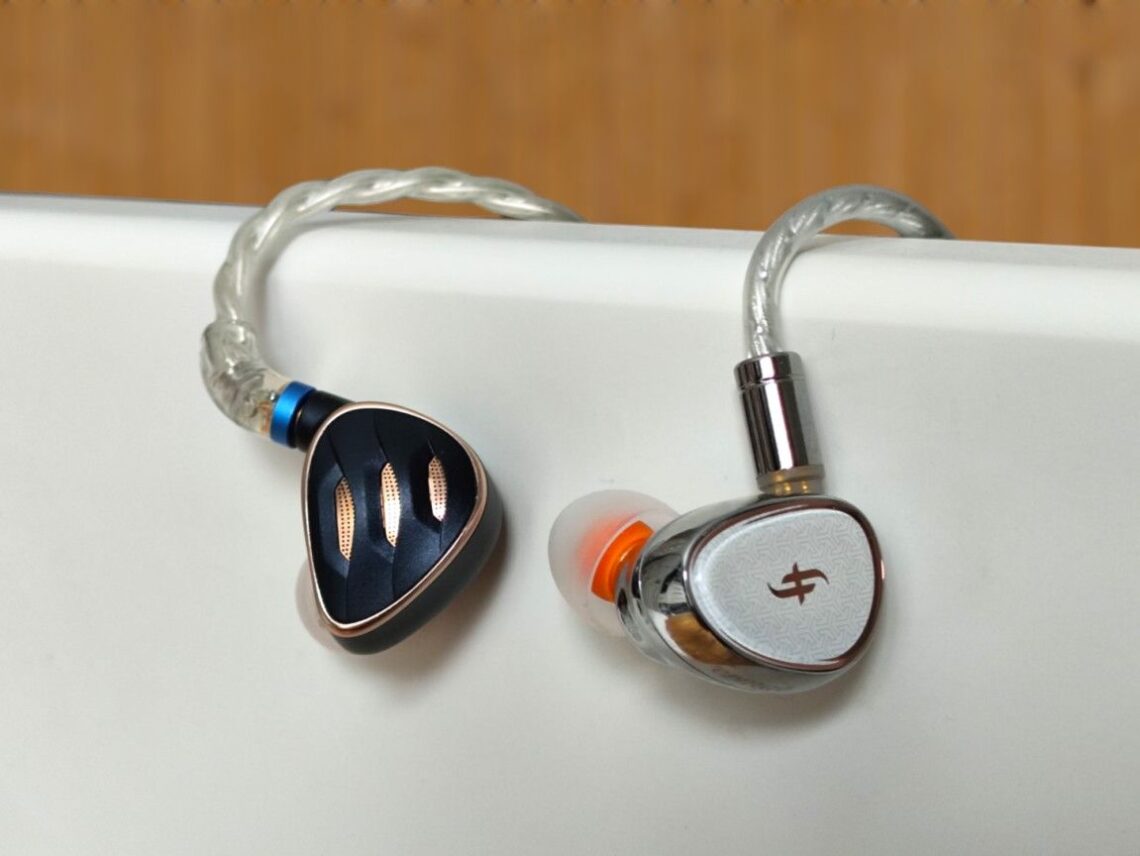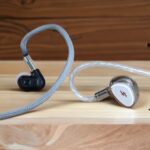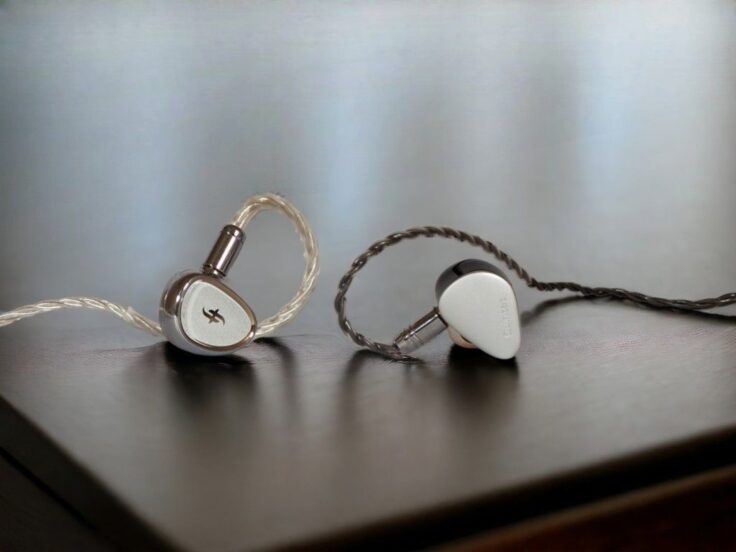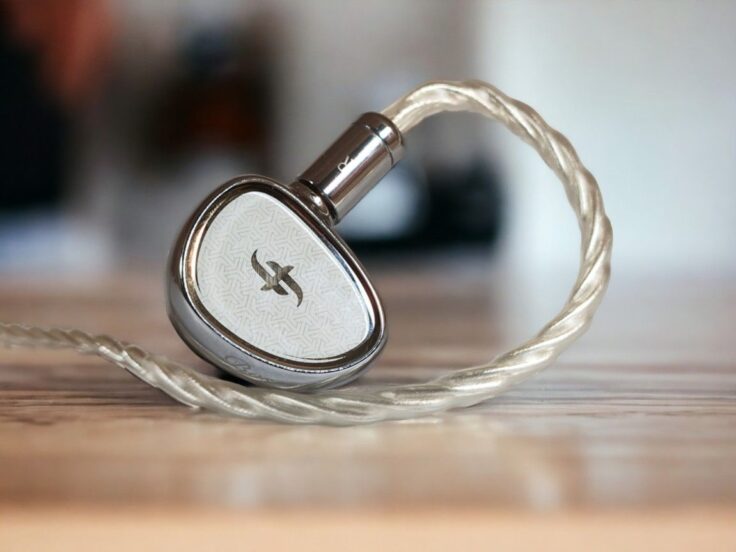The FiiO FH5S has 4 drivers per side, in other words, a Quad-Driver Configuration, with a 2BA+2DD architecture: A 12mm Beryllium-plated diaphragm Dynamic Driver (DD) covers the bass, a 6mm Beryllium-plated Dynamic Driver (DD) covers the midrange and two Balanced Armature drivers in the form of Knowles TWFK-30017 takes care of the high-frequencies.
The body is made of three parts of CNC-machined aluminium-magnesium alloy. It is an acoustically semi-open design with vents on the face plate.
There are three sound tuning switches. These will give you increased bass, reduced mids and increased treble, respectively. They can be combined in a total of 8 configurations.
The cable is a high purity monocrystalline silver-plated copper cable with interchangeable termination plugs (2.5/3.5/4.4 included). There are MMCX connectors on the earphone.
There’s also a FH5S PRO version available. The only difference between the two versions is the cable. The cables are of differently constructed in the ear that the normal version has 4 strands with 120 words each. The FH5S PRO has 19 strands with 8 wires each. Both are made of high purity monocrystalline silver-plated copper, braided in Litz style. They are easily distinguished from eachother because the normal version has a bright silver look, while the PRO version has a dark gray colour. .
The EA1000 features a single 10mm Dynamic Driver (DD) that takes care of the whole frequency spectrum. It’s set up to work along the of a 6mm Passive Radiator (PR), a passive diaphragm that regulates the air volume inside the housing. The EA1000 comes with 3 different types of detachable nozzles that are very effective and give 3 well implemented tuning possibilities. The EA1000 has a metal housing and is significantly heavier than the FH5S, but still sits nicely and comfortably in the ear. The FH5S is, however, larger.
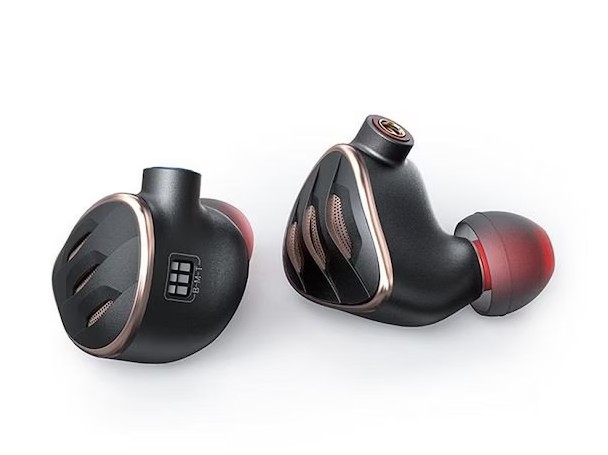
FiiO FH5S SPECIFICATIONS
- Drivers: 12mm beryllium-plated diaphragm/PU gasket + 6mm Beryllium-plated + Knowles TWFK-30017 compound BA
- Impedance: 40Ω(@1kHz )
- Sensitivity: 106dB/mW
- Frequency Response: 10Hz – 40kHz
- Weight: Approx. 8.8g (single ear unit)
- Max Power Input: 100mW
- Earphone Connector: MMCX
- Headphone Plug: 2.5/3.5/4.4mm gold-plated plug
- Cable Length: 120cm
- 3 dip switches for increased bass, lowered mids and increased highs, respectively.
Linsoul: FiiO FH5S
Amazon: FiiO FH5S
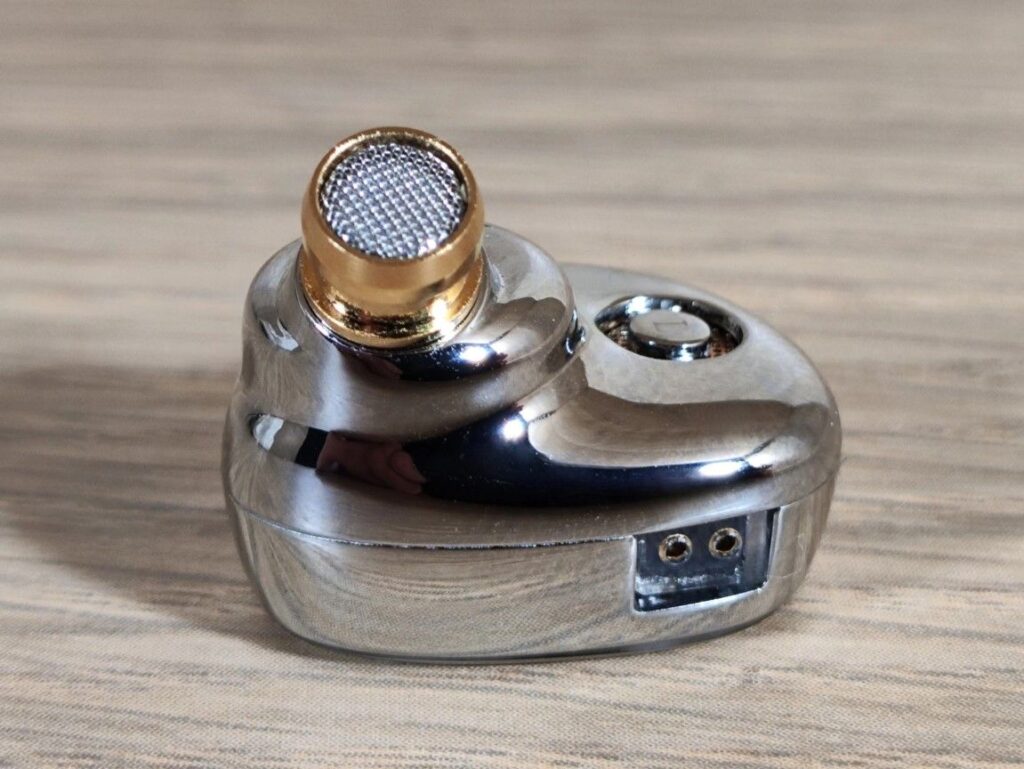
SIMGOT EA1000 SPECIFICATIONS
- Driver: 10mm Dual-Magnetic & Dual-Cavity Dynamic Driver, 1 Passive Radiator
- Diaphragm: Multi-Layer Sputter Deposition Purple-Gold Diaphragm
- Impedance: 16 Ohms ±15% (@1kHz)
- Sensitivity: 127 dB/Vrms (@1kHz)
- Frequency Response: 10Hz-50kHz
- Effective Frequency Response: 20Hz-20kHz
- Included Detachable Cable: 120 cm Silver-Plated OFC Litz Cable
- Cable plug: 3.5mm
- Attachment plugs IEM: 0.78mm 2 pin
- 3 pairs of tuning nozzles included
Linsoul: Simgot EA1000
Amazon: Simgot EA1000

COMPARISONS
In this comparison, the EA1000 has the golden brass nozzles installed. Medium bass, medium treble. This is my preferred nozzles
The FiiO FH5S has all switches set to the off/down position: Bass boost off, midrange reduction off, and treble boost off. This is the stock setting and also my preferred tuning.
Associated equipment: Topping A90 amp and the RME ADI-2 DAC FS as a source.
TRACK BY TRACK COMPARISON:
Jambi by Tool
Starting with the FH5S, it sounds really great and there are so many textures and layers in the noisy riffs. I am really impressed with the FH5S here.
The EA1000 is also very impressive. It’s maybe even more detailed, but in a rounder way. It sounds more organic and fuller. Not that the FH5S is thin sounding, rather slightly dry – but in a warm and nice sounding way.
Bored by Deftones
Starting with the EA1000, things sound good. Very good texture to the fuzz guitars, the bass is plentiful but not overdone. It sounds nicely balanced.
Moving on with the FH5S, the textures in the fuzz guitar riffs get more apparent and articulate, there is more separation and easier to follow different layers in the music. I think this might have to do more with frequency response than technical ability, but no matter the reason I prefer the FH5S here.
The Bend by Pearl Jam
The EA1000 has a wonderful presentation. Eddie Vedder’s vocals are beautifully rendered. The bass is powerful. The soundstage is large, imaging precise. There is lots of detail but it all blends very nicely together as a whole.
With the Fiio FH5S, the bass is more uneven. The vocals are flatter sounding. There are less dynamics and the separation between instruments is not as good.
Escape Route by Boris Blank
Very nice and spacious presentation from the FH5S. Lots of texture and detail. It’s got this dry warmth to its tonality. Great separation of instruments and imaging.
The EA1000 is warmer and thicker sounding. I find it to be a more organic presentation. It’s a bit less spacious, with less clearly articulated details, yet they are still all there.
As Before by Olga Konkova
The Fiio FH5S delivers a great performance. The bass is punchy, there’s a nice sense of space. The vocals sound a bit dry, maybe.
Moving on to the EA1000, everything opens up and becomes more natural and organic, dynamics improve and the imaging is better with great separation. The vocals have a lot more detail and sound more natural with more subtle nuance.
Almost Like the Blues by Leonard Cohen
The FiiO FH5S sounds very good. Good amounts of detail and a nicely balanced presentation. It has this dry warmth to its sound that’s quite appealing. The EA1000 has a relatively similar sound. It’s slightly more dynamic and spacious sounding.
Black Crow by Cassandra Wilson
Starting with the EA1000, I think this sounds terrific. Everything sounds well-balanced, natural and effortless. There is so much happening in this track and all the subtleties and ambient sounds are rendered fabulously.
The FH5S also delivers a very nice performance. However, it sounds less dynamic. There is less fine detail and both micro dynamics and macro dynamics are suffering in direct comparison to the EA1000. There is less detail and everything blends together a bit more with less separation and space between instruments.
Desert Island Disk by Radiohead
This sounds good with the EA1000, but when changing to the FH5S, it just sounds more interesting. There’s something about the textures, there’s a greater sense of separation and details are better articulated with the FH5S with this track.
It Could Be Sweet by Portishead
I’m starting with the FH5S. The bass is just right, full but not overdone. The vocals are present and tender. There’s a nice sense of space and image depth.
The EA1000 is also very well-balanced. At least as much detail as the FH5S. However, it sounds more rounded. It is more organic sounding but there is still something about the FH5S that’s very appealing. I really like both presentations. In terms of sound signature and frequency response, they are quite similar sounding.
Spontanius Compositorius by Thomas Agergaard
This sounds really beautiful with the EA1000. It’s very natural and organic sounding, with good tonal weight yet with lots of space and subtle detail. The percussion is not too bright. The bass is powerful. It’s not too much, but it’s close.
The FH5S also delivers a very nice presentation. The percussion is definitely brighter sounding – more than I prefer. The saxophone has a dry warmth to its tonal character which is quite nice. The bass is also less rounded and with more apparent texture than with the EA1000.
I definitely prefer the EA1000 here. The FiiO FH5S is bordering on sibilance with the bright percussion – and that is with the treble boost switch turned off.
Young Vivaldi Violin Concerto RV813 III by Ensemble Modo Antiquo
Starting with the FH5S, this piece sounds mesmerizing. There is this dry warmth that I keep coming back to which sounds absolutely amazing because it makes all the textures in the strings come through. There are lots of details and those ambient background sounds are making it a great experience.
The EA1000 also sounds wonderful. It’s rounder, again it sounds more organic. All the detail and all the texture is there but it’s not as sharply cut. It is just as enjoyable as the FH5S, just a bit different.
Mahler’s Symphony No. 2 – III by Paavo Järvi
The dynamic range in this piece is unusually large these days, but the EA1000 handles it perfectly. All the tiny ambient little sounds and layers of melodies are subtly brought to your attention and when it gets really loud with the brass instruments, it’s not harsh, just intense.
The FH5S also sound great. It offers great separation and a huge space with lots of small details. Again, it sounds a bit drier, but not cold or clinical. The brass instruments are a bit crisper than with the EA1000, I find the EA1000 crisp enough.
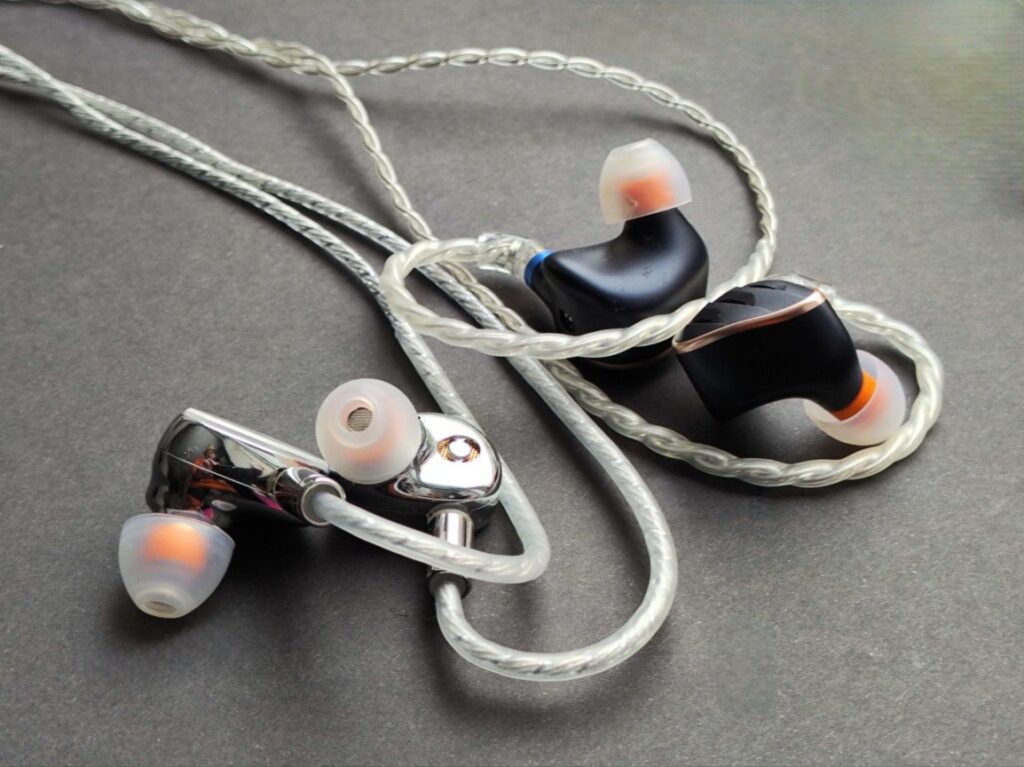
WRAPPING IT UP
First, let me reiterate that I used the EA1000 with the golden brass nozzles and the FH5S with all tuning switches turned off. If I was to compare all 3 tunings of both earphones it would take a while.
Sounds Signature and Timbre
With regards to bass quantity and midrange and treble presence, they are quite similar. The EA1000 has a bit more bass, the FH5S has a bit more treble. It is not the differentiating factor. What I keep coming back to is that the FH5S has a “dry warmth” while the EA1000 is more rounded and organic sounding with more tonal weight and body.
I would say that the EA1000, in general, has a more natural-sounding timbre, it’s more rounded and feels very effortless. The FH5S is fascinating in its own way and especially with the rock, metal and electronic tracks I listened to, it sounds generally a bit better and more engaging.
Bass
Keep in mind that this comparison is exclusively focusing on the tunings that I have chosen, not experimenting with the tuning alternative options. Both are set to the tunings that give medium bass quantity.
I tend to find that the EA1000 has a little bit more bass presence and it has a rounder, slightly fuller sound. The textures are more apparent with the FH5S, but when you listen, the details are all there with the EA1000 too. They are just presented in a more organic-sounding way.
Midrange
They both have good presence in the mids, but the way they render the midrange is different. With the FH5S, vocals and midrange instruments have a dry warmth to their sound. It is often a very nice rendering. It makes it easier to identify textures and the details are a bit more articulated.
The EA1000 presents vocals and other mid-range oriented instruments in a more organic and liquid manner. The mids are highly detailed but not as sharply cut as with the FH5S.
Which I prefer varies from track to track but both are really good sounding – they are just different.
Treble
In its stock configuration, the FH5S already has a relatively crisp-sounding treble. It is very sparkly and mostly quite well-defined. A few times I have found it to be a bit too bright for my liking and it sometimes gets a bit too close to sibilance. Mostly, however, I find it to sound great. It’s quite airy.
With the golden brass nozzles, the EA1000 has a relatively neutral treble presence. It’s very detailed, but in a more liquid and organic-sounding way. The edges are not as clear and crisp as with the FH5S, but there’s lots of information still.
Dynamics and Detail
Both these earphones have lots of detail and great dynamics. Which one has more depends often on the track. They have different strengths and variations in their respective frequency response will affect the way they sound a bit differently from track to track.
Soundstage and Imaging
Mostly, I find that they have a very good and similar sounding sound stage in terms of width, height and depth. Imaging capabilities are also on the same level, although I often find the EA1000 a hair or two better.
TUNING OPTIONS
The EA1000 comes with 3 very effective tuning nozzles: Nozzle 1 (Steel with Red Ring) is the one mounted on the EA1000 when you get it, and often the one used in reviews. It’s relatively bass-heavy with mellow highs and mids. This is my least preferred tuning, personally. Nozzle 2 (Golden Brass with Clear Ring) has less bass and a relatively brighter-sounding treble along with more relative midrange presence. This is the nozzle used here in my comparison with the FiiO FH5S. It’s also my favourite all-round choice. Nozzle 3 (Steel with Black Ring) has a very neutral bass, a crisper treble – along with an upfront midrange. I like this tuning quite a lot.
The FiiO FH5S has 3 dip switches on the housing, which can be switched on and off. One switch increases the bass, the next brings down the mids and the third elevates the highs. These switches can be combined and it gives you a total of 8 tuning settings. I had all switches set to the OFF position. Boosted bass off, boosted highs off, reduced mids off. This is my preferred setting and also the setting that comes pre-configured.
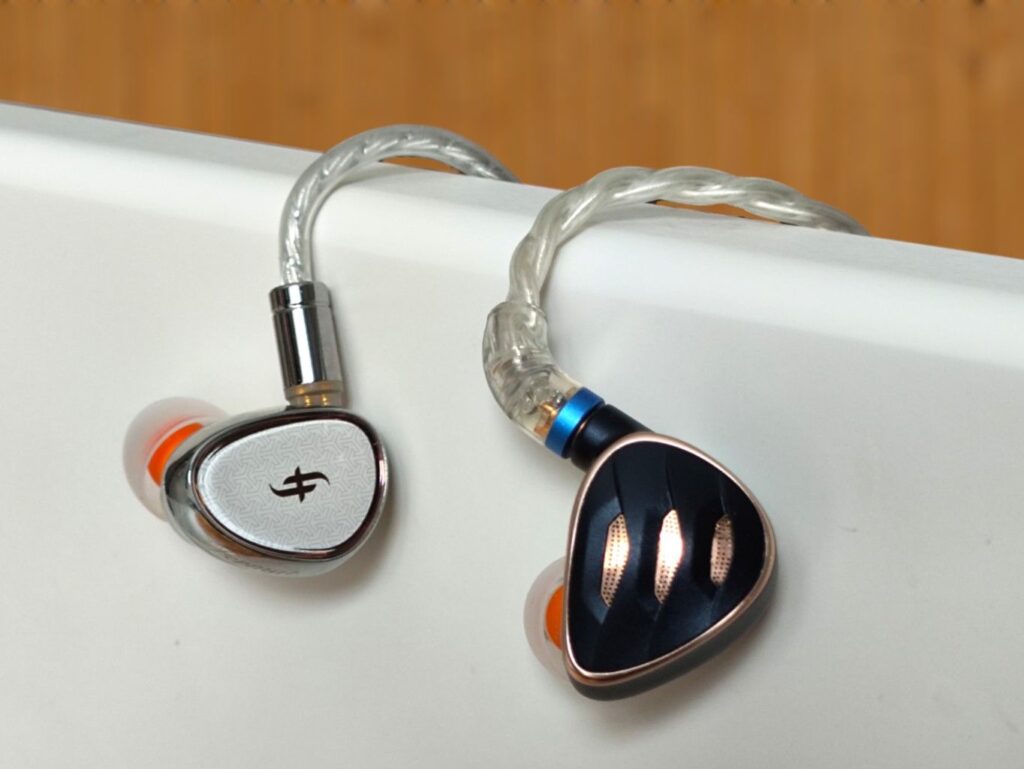
CONCLUSION
When I tested these two earphones with the tuning configurations I selected, I found many similarities as well as notable differences.
The tonal balance is not very far apart. I like the sound signature of both. Neither are too bassy, both have nice presence in the midrange, and both have detailed highs that aren’t too bright. They have a wide and open soundstage with good imaging.
The main difference is that they have different ways of presenting the music. The FH5S has a dry warmth to its sound and excels at conveying textures. The EA1000 is more organic and liquid, yet still highly detailed.
Product links:
Buy on Linsoul: FiiO FH5S
Buy on Amazon: FiiO FH5S
Buy on Linsoul: Simgot EA1000
Buy on Amazon Simgot EA1000
We make earnings through affiliate links and any purchase you make on Amazon or Linsoul clicking one of our links will give us a small provision at no cost to you.
We only get a provision for items that are not returned, so there’s no incentive for us to recommend something that’s not good.
Linsoul : Headphones, Earbuds, Wireless Earbuds, Desktop DAC/AMP, Portable DAC/AMP, Digital Audio Players,
Amazon: Headphones, IEMs, Headphone Amplifiers, Home Audio or Anything else.
.
If you enjoyed this article or other content on The Headphoneer, you might consider leaving a small donation to keep this website up and running. No donation is too small. Thanks for supporting us!
If you like our work please follow us on Instagram, Facebook and Twitter , it will help us grow. Sharing is caring 🙂


